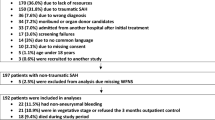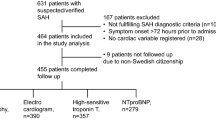Abstract
Background and Purpose
Cardiac injury is common after subarachnoid hemorrhage (SAH) and is associated with adverse early outcomes, but long-term effects are unknown. The first aim of this study was to compare the long-term rates of death, stroke, and cardiac events in SAH survivors versus a matched population without SAH. The second aim was to quantify the effects of cardiac injury on the outcome rates.
Methods
This was a retrospective cohort study of patients with and without non-traumatic SAH. For aim #1, the predictor variable was SAH and the outcome variables were all-cause and cerebrovascular mortality, stroke, cardiac mortality, acute coronary syndrome (ACS), and heart failure (HF) admission. A multivariable Cox proportional hazards analysis was performed. For aim #2, the predictor variables were cardiac injury (elevated serum cardiac enzymes or a diagnosis code for ACS) and dysfunction (pulmonary edema on X-Ray or a diagnosis code for HF).
Results
Compared with 4,695 members without SAH, the 910 SAH patients had higher rates of all-cause mortality (hazard ratio [HR 2.6], 95% confidence intervals [CI] 2.0–3.4), cerebrovascular mortality (HR 30.6, CI 13.5–69.4), and stroke (HR 10.2, CI 7.5–13.8). Compared with the non-SAH group, the SAH patients with cardiac injury had increased rates of all-cause mortality (HR 5.3, CI 3.0–9.3), cardiac mortality (HR 7.3, CI 1.7–31.6), and heart failure (HR 4.3, CI 1.53–11.88).
Conclusions
SAH survivors have increased long-term mortality and stroke rates compared with a matched non-SAH population. SAH-induced cardiac injury is associated with an increased risk of death and heart failure hospitalization.




Similar content being viewed by others
References
Burch GE, Meyers R, Abildskov JA. A new electrocardiographic pattern observed in cerebrovascular accidents. Circulation. 1954;9:719–23.
Andreoli A, di Pasquale G, Pinelli G, Grazi P, Tognetti F, Testa C. Subarachnoid hemorrhage: frequency and severity of cardiac arrhythmias. Stroke. 1987;18:558–64.
Horowitz MB, Willet D, Keffer J. The use of cardiac troponin-I (cTnI) to determine the incidence of myocardial ischemia and injury in patients with aneurysmal and presumed aneurysmal subarachnoid hemorrhage. Acta Neurochir. 1998;140:87–93.
Hachinski VC, Smith KE, Silver MD, Gibson CJ, Ciriello J. Acute myocardial and plasma catecholamine changes in experimental stroke. Stroke. 1986;17:387–90.
McGirt MJ, Blessing R, Nimjee SM, et al. Correlation of serum brain natriuretic peptide with hyponatremia and delayed ischemic neurological deficits after subarachnoid hemorrhage. Neurosurgery. 2004;54:1369–73. discussion 73–4.
Kopelnik A, Fisher L, Miss JC, et al. Prevalence and implications of diastolic dysfunction after subarachnoid hemorrhage. Neurocrit Care. 2005;3:132–8.
Crago EA, Kerr ME, Kong Y, et al. The impact of cardiac complications on outcome in the SAH population. Acta Neurol Scand. 2004;110:248–53.
Olafsson E, Hauser WA, Gudmundsson G. A population-based study of prognosis of ruptured cerebral aneurysm: mortality and recurrence of subarachnoid hemorrhage. Neurology. 1997;48:1191–5.
Lehecka M, Niemela M, Seppanen J, et al. No long-term excess mortality in 280 patients with ruptured distal anterior cerebral artery aneurysms. Neurosurgery. 2007;60:235–40. discussion 40–1.
Ronkainen A, Niskanen M, Rinne J, Koivisto T, Hernesniemi J, Vapalahti M. Evidence for excess long-term mortality after treated subarachnoid hemorrhage. Stroke. 2001;32:2850–3.
Tung P, Kopelnik A, Banki N, et al. Predictors of neurocardiogenic injury after subarachnoid hemorrhage. Stroke. 2004;35:548–51.
Iribarren C, Tekawa IS, Sidney S, Friedman GD. Effect of cigar smoking on the risk of cardiovascular disease, chronic obstructive pulmonary disease, and cancer in men. N Engl J Med. 1999;340:1773–80.
Go AS, Chertow GM, Fan D, McCulloch CE, Hsu CY. Chronic kidney disease and the risks of death, cardiovascular events, and hospitalization. N Engl J Med. 2004;351:1296–305.
Arellano MG, Petersen GR, Petitti DB, Smith RE. The California automated mortality linkage system (CAMLIS). Am J Public Health. 1984;74:1324–30.
Yarlagadda S, Rajendran P, Miss JC, et al. Cardiovascular predictors of in-patient mortality after subarachnoid hemorrhage. Neurocrit Care. 2006;5:102–7.
van Gijn J, Kerr RS, Rinkel GJ. Subarachnoid hemorrhage. Lancet. 2007;369:306–18.
Al-Shahi R, White PM, Davenport RJ, Lindsay KW. Subarachnoid hemorrhage: lumbar puncture for every negative scan? Authors’ reply. BMJ. 2006;333:550.
Kawasaki T, Azuma A, Sawada T, et al. Electrocardiographic score as a predictor of mortality after subarachnoid hemorrhage. Circ J. 2002;66:567–70.
Mayer S, Lin J, Homma S, et al. Myocardial injury and left ventricular performance after subarachnoid hemorrhage. Stroke. 1999;30:780–6.
Lambert G, Naredi S, Eden E, Rydenhag B, Friberg P. Sympathetic nervous activation following subarachnoid hemorrhage: influence of intravenous clonidine. Acta Anaesthesiol Scand. 2002;46:160–5.
Naredi S, Lambert G, Eden E, et al. Increased sympathetic nervous activity in patients with nontraumatic subarachnoid hemorrhage. Stroke. 2000;31:901–6.
Banki NM, Kopelnik A, Dae MW, et al. Acute neurocardiogenic injury after subarachnoid hemorrhage. Circulation. 2005;112:3314–9.
Banki N, Kopelnik A, Tung P, et al. Prospective analysis of prevalence, distribution, and rate of recovery of left ventricular systolic dysfunction in patients with subarachnoid hemorrhage. J Neurosurg. 2006;105:15–20.
Sommargren CE. Electrocardiographic abnormalities in patients with subarachnoid hemorrhage. Am J Crit Care. 2002;11:48–56.
Coghlan LA, Hindman BJ, Bayman EO, et al. Independent associations between electrocardiographic abnormalities and outcomes in patients with aneurysmal subarachnoid hemorrhage: findings from the intraoperative hypothermia aneurysm surgery trial. Stroke. 2009;40:412–8.
Acknowledgments
The Sources of Funding are Kaiser Foundation Research Institute: Community Benefits awards program and NIH: K23 NS058357-01 and R01 NS034949.
Conflicts of interest
None.
Author information
Authors and Affiliations
Corresponding author
Electronic supplementary material
Below is the link to the electronic supplementary material.
Rights and permissions
About this article
Cite this article
Zaroff, J.G., Leong, J., Kim, H. et al. Cardiovascular Predictors of Long-Term Outcomes After Non-Traumatic Subarachnoid Hemorrhage. Neurocrit Care 17, 374–381 (2012). https://doi.org/10.1007/s12028-011-9592-x
Published:
Issue Date:
DOI: https://doi.org/10.1007/s12028-011-9592-x




